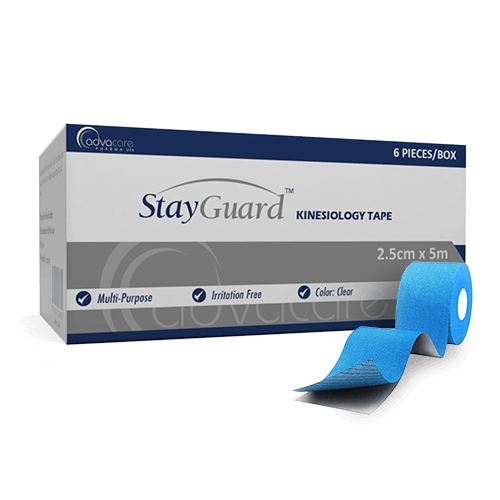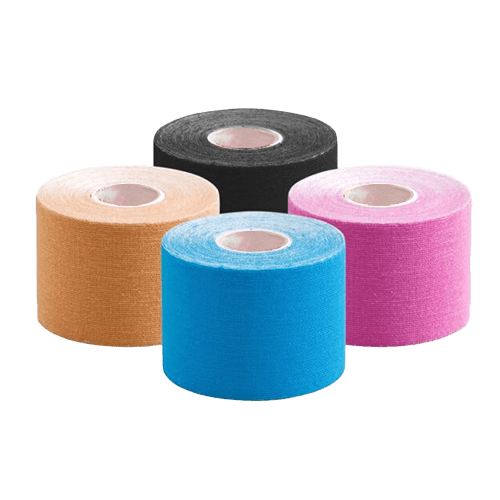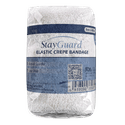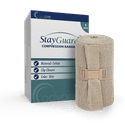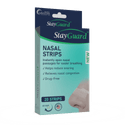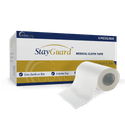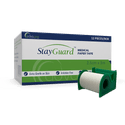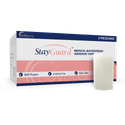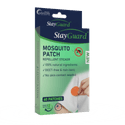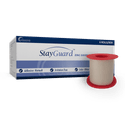- Home›
- Medical Devices›
- Skin & Wound Care›
- Medical Tapes›
- Kinesiology Tape
Kinesiology Tape
Material
Color
Size
Packaging
What is a Kinesiology Tape?
Kinesiology Tape is a flexible adhesive tape that is applied to the body to provide support, reduce pain, and help improve muscle and joint function during physical activity or as part of rehabilitation. This medical tape is made of stretch cotton and is available in various sizes and colors.
Kinesiology tape is a popular choice for athletes and fitness enthusiasts who are looking for a way to improve their performance and reduce pain. The tape is also used by physical therapists and other healthcare professionals to help patients recover from injuries.
AdvaCare Pharma produces Kinesiology Tapes in ISO and CE-certified facilities located in India, China, and the USA. Maintaining compliance with healthcare and regulatory standards, our manufacturing plants undergo regular inspection to ensure consistent quality and safety.
Product Specifications
Material
Kinesiology Tape is a breathable, comfortable, and easy-to-apply tape that can be used to support muscles and joints, reduce pain, and improve range of motion. It is made of 95% cotton and 5% spandex, and it has an elasticity of 170% to 180%. The acrylic adhesive is strong and durable, and it will not leave any residue on the skin. Kinesiology tapes are hypoallergenic and will not irritate the skin.
Why are we a top Kinesiology Tape manufacturer?
AdvaCare Pharma is a leading manufacturer of Kinesiology Tapes and other high-quality medical tapes and adhesives for orthopedic use. We strive to deliver innovative solutions that are not only technologically advanced but also environmentally friendly, perfectly attuned to the dynamic demands of healthcare providers and patients worldwide. Our production facilities, certified by ISO and CE, are located in China, India, and the USA.
With a wealth of experience spanning over two decades, AdvaCare Pharma has established a robust distribution network covering 65 markets across the globe. Our close collaborations with distributors play a pivotal role in our success story. By cultivating strong relationships, we are able to develop customized solutions that address our partners requirements. Our mission is to uplift patient outcomes and enhance the overall quality of life by offering exceptional medical devices that set industry benchmarks.
Uses
How should Alginate Dressing be used?
To properly utilize alginate dressing:
- Begin by meticulously cleansing the wound and preparing the wound bed to optimize healing conditions.
- After guaranteeing a sterile environment, carefully unpack the alginate dressing and gently apply it over the wound, checking for full coverage and slight overlap beyond the wound edges. If the wound is heavily exuding, consider lightly moistening the dressing with sterile saline to activate its absorbent properties.
- Secure the dressing in place with an appropriate secondary dressing to keep its position and protect the wound site.
- Regular monitoring of the dressing and the wound's progress is required, along with adhering to healthcare provider instructions regarding dressing changes and wound care protocols to mitigate the risk of complications.
What precautions should be considered when using Alginate Dressing?
When utilizing alginate dressing, monitor the dressing regularly to evaluate the degree of exudate absorption and the overall progress of wound healing. Given that alginate dressings are intended to absorb moisture and foster a moist wound environment conducive to healing, adherence to the suggested frequency of dressing changes outlined in the product instructions and tailored to the wound's condition is paramount.
Routine assessment of the wound for any indications of infection, excessive exudate, or potential complications is paramount. Consulting with a healthcare professional for guidance and adjustments to the treatment plan as needed aids in wound management and encourages favorable outcomes.
Can Alginate Dressings be used on all types of wounds?
Alginate dressings are particularly suitable for moderately to heavily exuding wounds, including venous ulcers, pressure ulcers, diabetic foot ulcers, and surgical wounds.
The high absorbency of alginate fibers enables them to manage exudate very well, making them ideal for wounds with moderate to high levels of wound fluid. However, alginate dressings may not be suitable for wounds with minimal exudate or dry wounds, as they need moisture to function correctly.
Wounds with exposed structures such as bones or tendons may require an additional layer of protection, such as a secondary dressing, to prevent direct contact with the alginate dressing.
How should Alginate Dressings be applied to wounds?
To apply alginate dressings to wounds:
- Begin by preparing the wound bed according to standard wound care protocols, guaranteeing that it is clean and free from debris.
- Select an appropriately sized alginate dressing based on the dimensions and exudate level of the wound.
- Place the alginate dressing directly onto the wound surface, checking that it covers the entire wound bed and extends slightly beyond the wound margins.
- If needed, lightly moisten the dressing with sterile saline solution to activate its absorptive properties.
- Secure the alginate dressing in place using an appropriate secondary dressing, such as a non-adherent pad or adhesive tape.
- Confirm that the dressing is properly secured and that the wound is adequately protected.
What are the advantages of using Alginate Dressings over traditional wound dressings?
Alginate dressings present several advantages over traditional wound dressings, making them a preferred choice in many clinical settings:
- Alginate dressings have superior absorbent properties, capable of absorbing up to 20 times their weight in wound exudate. This high absorbency helps to preserve a moist wound environment, which is foundational for fostering maximum wound healing.
- Alginate dressings conform easily to the contours of the wound bed, making for a snug fit and maximum contact with the wound surface.
- The gel formed by alginate fibers upon contact with wound exudate gives a protective barrier against microbial contamination, reducing the risk of infection.
The properties of alginate dressings contribute to faster wound healing, elevated patient comfort, and better clinical outcomes.
What factors should be considered when selecting Alginate Dressings for wound management?
When selecting alginate dressings for wound management, several factors should be taken into consideration to obtain ideal outcomes:
- Assess the wound characteristics, including size, depth, and exudate level, to determine the appropriate dressing type and size.
- Alginate dressings are suitable for moderately to heavily exuding wounds, so make sure that the wound produces enough exudate to benefit from the absorbent properties of alginate fibers.
- Consider the patient's medical history, allergies, and skin sensitivity when choosing dressing materials to minimize the risk of adverse reactions.
- Evaluate the wound location and surrounding tissue condition to select a dressing that conforms well to irregular wound shapes and contours.
- Consult with a healthcare professional or wound care specialist to determine the most suitable alginate dressing and develop a comprehensive wound management plan tailored to the individual patient's needs.
FAQs
How does a Kinesiology Tape work?
Kinesiology tape is a type of elastic tape that is applied to the skin. It is designed to help support muscles and joints, reduce pain, and improve range of motion. The tape works by lifting the skin slightly, which creates space between the skin and the underlying tissues. This space allows for increased blood flow and lymphatic drainage, which can help to reduce inflammation and pain.
How is Kinesiology Tape applied?
Kinesiology tape is applied by a trained professional. The tape is cut to the desired length and width and then applied to the skin in a specific pattern. The tape should be applied in a way that supports the muscles and joints without restricting movement.
Are there different ways to apply Kinesiology Tape?
Yes, there are different ways to apply kinesiology tape. The most common way is to apply it in a straight line, but it can also be applied in a variety of other patterns, such as X's, Y's, or spirals. The specific pattern used will depend on the area of the body that is being treated and the desired effect.
How should Kinesiology Tape be stored and handled?
Kinesiology tape should be stored in a cool and dry place. It should be handled with clean hands and should not be dropped. The tape should also be removed after 3-5 days of use.

You might be interested in...
Why AdvaCare Pharma?
As an industry leader, we are aware of our responsibility to provide affordable and sustainable solutions to improve healthcare worldwide.
